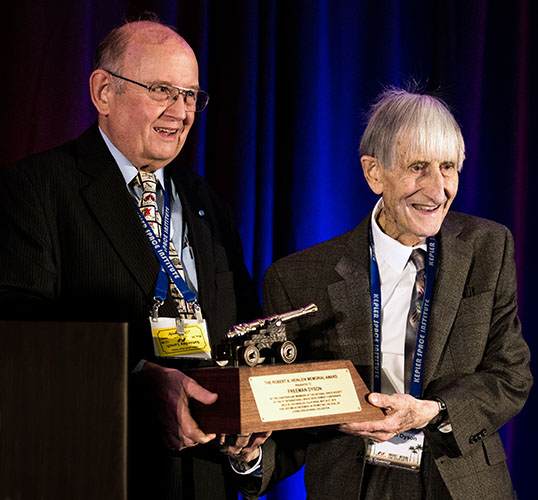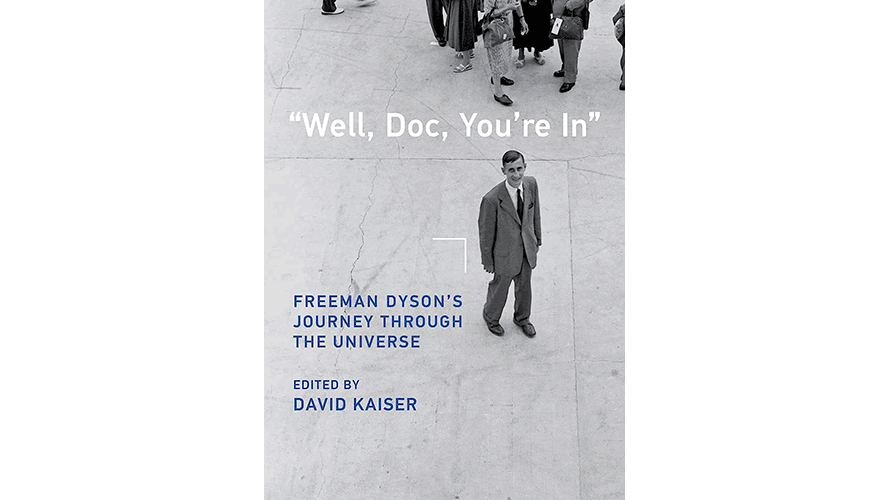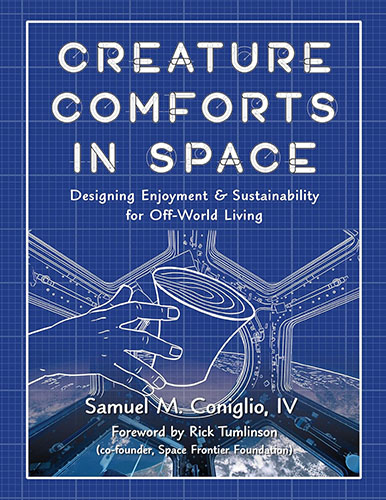Category: Nonfiction
Reviewed by: John J. Vester
Title: Well, Doc, You’re In: Freeman Dyson’s Journey through the Universe
Editor: David Kaiser
Format: Hardcover/Kindle
Pages: 304
Publisher: MIT Press
Date: October 2022
Retail Price: $29.95/$17.99
ISBN: 978-0262047340
Find this book
This biography of Freeman Dyson from The MIT Press, edited by David Kaiser, will be a revelation to readers who thought they knew this thin English scientific and mathematical giant. Those discovering this towering intellectual genius through this book will come away shaking their heads, saying, “What a mind!”

The genius of Kaiser’s book is that each of its ten chapters was written by someone different…someone who knew the “Doc” or had worked with him, or had done deep research into some aspect of the man’s life or career.
Kaiser provides a wonderful Introduction, contributed Chapter 3, and appended an “About the Authors” section after the Acknowledgements. The authors represent the best in science and science writing, including such luminaries as Jeremy Bernstein and Dyson’s son, George. The skills of these practitioners, marrying science and art, make the 300 page book an effortless and pleasant read. For those who want to go deeper, each chapter includes extensive end notes.
What Dyson accomplished in his long life (he passed away in 2020 at the age of 96) makes it tempting to focus on the man instead of the book. But this book delves into his many outstanding achievements in mathematics, several sciences, technology and public policy, and does so in such a way as to give the non-scientists some understanding of the details and the significance.
The first three chapters of Hey, Doc, You’re In present, in sequence, Dyson’s evolution from slightly heretical student at Cambridge (Chapter 1, “That Secret Club of Heretics and Rebels” by Amanda Gefter) to his World War II work in the RAF Operational Research Section (Chapter 2, “Calculation and Reckoning: Navigating Science, War, and Guilt” by William Thomas) to his eventual success in synthesizing and expanding on the work of three top physicists in the new field of Quantum Electrodynamics (Chapter 3, “The First Apprentice” by David Kaiser). Dyson’s success was such that one of the three, Richard Feynman, leaned over to him during a New York physics conference and said, “Well, Doc, you’re in.”
After securing a lifelong position at the Institute for Advanced Study, where Einstein also resided, Dyson was free to follow his interests, as described by Robert Dijkgraaf in Chapter 4, “A Frog among Birds: Dyson as a Mathematical Physicist.” Dyson thought of himself as more of a frog, taking on random projects and reveling in the details like a frog in a pond, and jumping from pond to pond, rather than as a bird, flying overhead and only getting the big picture. His many amazing projects and his successes are related.
One such project came about as a result of his time working with General Atomic, a defense contractor near San Diego, California, as his son, George Dyson, explains in Chapter 5, “Single Stage to Saturn: Project Orion, 1957-1965.” The first fruit of Dyson Senior’s time there was the TRIGA nuclear reactor. It was designed with so many novel safety features that it was a huge success and many were built and are still in use today for the creation of isotopes, mainly for medical applications.
On the heels of that success, Dyson began to work with a group at General Atomic pursuing the idea of propelling a space ship by detonating nuclear bombs under it. George Dyson has written an entire book about his father’s time at General Atomic. Chapter 5 of the book under review here is an excellent distillation of that earlier work.
Dyson’s familiarity with weapons and his concern for public policy led to a fifty year involvement with “the Jasons,” an elite scientific advisory group. This possibly less well known aspect of Dyson’s life is clearly told in Chapter 6, “Dyson, Warfare, and the Jasons,” by Ann Finkbeiner.
In Chapter 7, “A Warm Little Pond: Dyson and the Origins of Life,” by Ashutosh Jogalekar, Dyson’s abiding interest in the question of the origin of life is brought out. Surprisingly, though perhaps not so surprising for Freeman Dyson, in view of his successes in everything he turned his mind to, he made significant contributions in this field as well. As in so much of his work, he tackled the question mathematically and established the “metabolism first” approach on a firm footing.
To underscore how wide ranging his interests were—how skillfully he inhabited his various little ponds—Chapter 8, “The Cosmic Seer,” by Caleb Scharf, details Dyson’s cosmological speculations. From his eponymous Dyson Sphere to his views about the far future of the universe, Dyson’s imaginings and the power of his intellect will leave the reader with an exhilarating and vast view.
Finally, Chapter 9, “A Bouquet of Dyson,” provides a glimpse into Dyson’s private life, from the perspective of a friend and colleague, Jeremy Bernstein. Followed by an uplifting “Coda: Not the End,” a fond retrospective by daughter Esther Dyson, the book is a fine tribute to one of the great minds of the century.
Illustrated by delightful family pictures, and decorated by the intriguing art of Laurent Taudin, this book is an intimate, well crafted sharing of a remarkable man’s life and career.
© 2023 John J. Vester





















1 thought on “Book Review: Well, Doc, You’re In: Freeman Dyson’s Journey through the Universe”
Dyson is one of the most fascinating of a fascinating group of physicists!